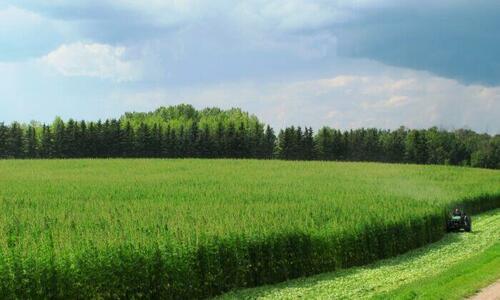Farmers Jump Off Hemp Bandwagon Amid Lack Of Profit And Underwhelming Performance
Authored by Autumn Spredemann via The Epoch Times (emphasis ours),
The use of hemp for industrial purposes—such as grain and fiber—has been the next big thing since the passing of a farm bill legalizing production in 2018.
Since then, a parallel market has sprouted up alongside the cannabinoid industry.
Unfettered optimism was high at the beginning, which triggered a moonshot planting in 2019.
Four years later, seasoned farmers and venture capitalists alike are struggling with a saturated market and oversold expectations on both ends of the industry.
Historically, advocates have marketed hemp as a sort of miracle crop with gusto. The movement gained serious traction as an investment within the United States once Cannabidiol (CBD) garnered a reputation for having medicinal benefits, which began in California in 1996.
Industrial applications followed once the United States Department of Agriculture (USDA) approved the bill to officially legalize hemp as an agricultural commodity, removing the plant’s long stigmatized status.
Just one year after legalization, licensed hemp plantings catapulted to 511,442 acres nationwide in 2019. Though by 2021, that number dropped to just 107,702 acres.
This year, licensed hemp acreage fell another 53 percent.
Some experts partly attribute this to blowback from supply wildly exceeding demand early in the game.
Organic hulled hemp seeds. (bhofack2/iStock)
“There were a lot of farmers that got involved in hemp in 2019—it was over-produced that year, and a lot of farmers were left with big bills and very little in the way of returns,” Mike Leago, founder of the iHempx, told The Epoch Times.
As the CEO of an international hemp exchange, Leago has worked across the hemp supply chain since 2016.
He says many “dishonest and malicious bad actors” within the industry have thrown a wrench into the nascent market. Some of this was done through unrealistic spreadsheet forecasts, driving a gold rush of investments.
“Oversupply became a reality,” he said.
Due to continued market congestion in 2021, some Oregon growers were stuck with thousands of pounds of hemp crops bagged and stacked inside their barns. By July, many couldn’t sell their harvest at a break-even price.
It’s a situation that’s become all too familiar among hemp farmers: a cash crop that’s not making any cash. Moreover, southwestern U.S. growers are facing additional challenges, like severe drought conditions.
In Texas, hemp enthusiasts touted the crop as a drought-resistant, economic life preserver. Though since 2019, farmers have yet to see any returns on their investments.
The president of the Texas Hemp Growers Association, Kyle Bingham, told reporters that “the interest is not there with farmers” this year. He added that growers don’t want to waste time, money, land, or anything else on hemp at the moment.
Some of this disgruntled sentiment is due to a notable underperformance amid widespread drought, which has affected 61 percent of the continental United States this year.
Water concerns are paramount in the notoriously arid Lone Star State, where farmers can’t afford to waste a single drop of water on crops that, quite literally, can’t take the heat.
And despite hemp’s street reputation as drought resistant, little research exists to support this.
On the contrary, a Colorado water study on hemp’s drought tolerance led by Katie Russell at Colorado State University noted that hemp isn’t an ideal “dryland crop.”
“To be candid, hemp is a plant, and extreme weather conditions are hard on crops,” director of the hemp fiber division and carbon offset for Global Smart Commodity Group, Nathan Murphy, told The Epoch Times.
Murphy asserted that misplaced expectations and poor long-term strategic planning account for a sizeable portion of early failures within the hemp industry. He also agrees with Leago’s assessment that self-proclaimed experts sabotaged the emerging market.
“I’ve heard them referred to as hemp prophets, making overly optimistic promises about cashing in on the ‘green rush,’ for a fee of course, to unsuspectingly vulnerable farmers,” he said.
Read more here…
Tyler Durden
Wed, 09/28/2022 – 05:00

